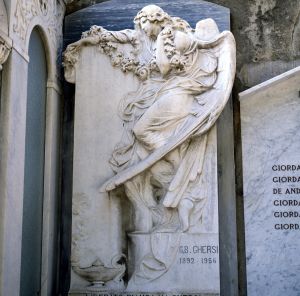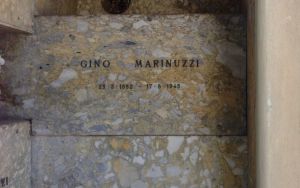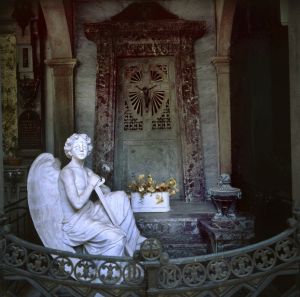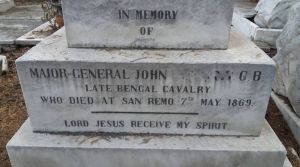Here lies the history of Sanremo
HIS HISTORY
"Our cemetery, which without exaggeration, after Genoa's cemetery, is by now the most splendid in Liguria for monuments" (cit. "Il Pensiero di Sanremo", 3 November 1889)".
The construction of the current monumental cemetery of the Foce is due to the initiative of the then mayor of Sanremo Siro Andrea Carli, who was in charge of the cemetery on June 6, 1838, for urban and hygienic reasons, considering that the ancient cemetery of Vallotto, dating back to 1775 in the area of Pian di Nave, between today's via Nino Bixio and the mouth of the San Romolo stream had proved to be too narrow and unsuitable, he ordered the transfer of the town cemetery to the new site located between today's corso Matuzia and the seashore behind the modern church of San Rocco. The reasons for the relocation were probably dictated by the fact that the old cemetery site was too narrow and unsuitable for emergencies such as the cholera epidemic that broke out in 1837, so much so that the municipal administration decided to move the cemetery to the Foce region with a resolution that, according to widespread oral tradition, was motivated by the fact that the old necropolis was too close to the house of the mayor Carli.
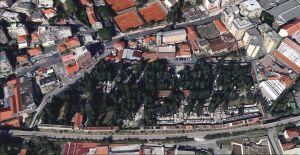 Initially the area was 4,050 square metres. (a quadrilateral of 90 x 45 metres), corresponding to the central and southern part of the present cemetery, i.e. the one surrounding the Church, and the entrance is on the north-east side.
Initially the area was 4,050 square metres. (a quadrilateral of 90 x 45 metres), corresponding to the central and southern part of the present cemetery, i.e. the one surrounding the Church, and the entrance is on the north-east side.
Following the increase in both the size of the city and that of the population, since then and until 1916 there have been numerous extensions that bring the surface of the cemetery to the current 20 thousand square metres.
Already thirty years after its inauguration (in April 1868) there will be the :
1 - first extension of 4,000 square metres towards the west, following the approval by the Prefect of Porto Maurizio of a project by architect Ammirati for the construction of a camp reserved for non-Catholics;
2 - a second extension will follow between 1877 and 1882, again towards the west, and the relative area of about 2500 sq.m. will be destined partly to Catholics and partly to non-Catholics;
3 - with the third extension, designed in September 1889 by the municipal engineer Semiglia, the expansion towards the west stops having reached the left bank of the San Bernardo stream. The following year another municipal technician, engineer Giorgio Lamborizio, will sign the general and final project of the cemetery, whose imprint coincides with the current one;
4 - on its basis, a few years later, the fourth enlargement will take place, this time in the opposite direction, i.e. towards the east in the south-east. From that moment and until the final project in 1916, the development of the plant will follow the architectural and functional approach elaborated by engineer Lamborizio, whose implementation after that time was instead partially abandoned for financial reasons and distorted by numerous superfetations imposed by contingent needs.
5 - with the fifth enlargement of 3,418 sq.m., of which 2,343 sq.m. for Catholics and 1,075 sq.m. for non-Catholics, which took place in 1895, the cemetery will once again expand on the western side, going northwards along the bank of the St. Bernard stream and approaching the provincial road.
6 - The sixth enlargement incorporates the notary Zunino deeded convention stipulated in January 1906 between the mayor Mombello and Countess Giuseppina Roverizio di Roccasterone widow Marsaglia, for the arrangement of the main entrance and the construction of the 80 square metre Marsaglia tomb and the connection of the cemetery to the provincial road through a 10 metre wide road that the Municipality should have built with the contribution of 10,000 lire offered by the noblewoman and on areas given by her for free.
7 - The seventh and last enlargement will cover 2,250 square metres and will take place in 1920 by engineer Lamborizio, who in 1916 had designed the final layout of the cemetery.
After these enlargements, as early as 1888, the cemetery of La Foce became the object of repeated and insistent proposals to move to a larger site, immediately located in a vast plot of land in Valle Armea, where the new city cemetery would be inaugurated in 1949. On 21st May of the same year the Sanremo Town Council decided to suppress the Foce cemetery, with the prohibition of further burials. The concession in the new Cemetery was free of charge for the time that was still missing at the expiry of the concession or in perpetuity, and also the transport of the mortal remains from the suppressed to the new Cemetery was free of charge.
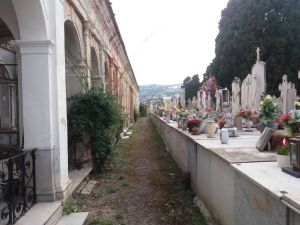 With a resolution of the Town Council of 22 April 1980 the cemetery of La Foce was declared "Monumental Cemetery". This decision was reconfirmed by the new and current Regulations of the Mortuary Police, drawn up between 1989 and 1990 following national provisions and adopted by the extraordinary commissioner with a resolution of 25 August 1993.
With a resolution of the Town Council of 22 April 1980 the cemetery of La Foce was declared "Monumental Cemetery". This decision was reconfirmed by the new and current Regulations of the Mortuary Police, drawn up between 1989 and 1990 following national provisions and adopted by the extraordinary commissioner with a resolution of 25 August 1993.
Article 95 establishes the following with regard to the historic cemetery of Matuzia: "The cemetery of the Mouth is erected as a Monumental Cemetery to preserve the memory of institutions, families and men who have deserved the City of Sanremo and to preserve works of art or works of particular cultural and historical value".
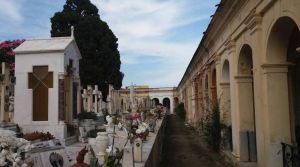 Considering the size of the city, a characteristic feature is the richness of burials of remarkable artistic quality and a large presence (about one third) of tombs of the numerous foreigners who at the end of the nineteenth - beginning of the twentieth century elected Sanremo and the Riviera a privileged destination for their holidays.
Considering the size of the city, a characteristic feature is the richness of burials of remarkable artistic quality and a large presence (about one third) of tombs of the numerous foreigners who at the end of the nineteenth - beginning of the twentieth century elected Sanremo and the Riviera a privileged destination for their holidays.
The cemetery of the Foce hosted burials until after the Second World War, when it could no longer expand due to the numerous buildings that had risen in the meantime around its area, and was reserved only for the old owners who had kept the right to burial there. A typical Ligurian cemetery, the necropolis of the Mouth, although currently in a state of semi-abandonment, still preserves numerous works of art, especially sculptural works, which refer to the most brilliant period of Sanremo Art Nouveau, of which the workers, architects and clients often share.
At the entrance to the cemetery stands the Marsaglia family chapel, whose original project was commissioned in 1901 by the widow of Giovanni Marsaglia, Giuseppina Roverizio, to 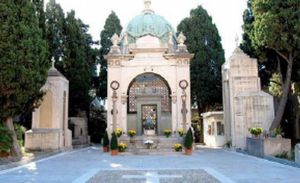 the architect Pio Soli.
the architect Pio Soli.
The Marsaglia heirs then asked the Municipality for a space of about 60 square metres to build the new chapel. However, since this land was not available and the area in front of the cemetery belonged to the Marsaglia family, the heirs offered to donate this 2600 square metres of land and to fence it at their own expense. However, this generous offer was not immediately accepted, but had to undergo a series of bureaucratic delays, until after 1903 it was accepted.
On 23 March 1904 the project for the funeral chapel of Giovanni Marsaglia was drawn up in Turin by Giovanni Vacchetta and Pietro Canonica.
The former, full professor of Ornaments at the Royal Industrial Museum and at the School of Application for Engineers in Turin, was mainly responsible for the pictorial decoration of the building, took care of the details that embellish the dome and the perimeter of the chapel, and created the bronze medallions, the stained-glass window, the polychrome marbles, the vases and the columns that support the laurel wreaths. Canonica was instead the author of the artistic marble groups placed inside and representing La Pietà and some Pleureuses, of purely symbolist taste. Official sculptor of the Marsaglia family, Canonica applied at best his knowledge of the floral style assimilated in Turin at the beginning of the twentieth century, just in the period in which he worked in our city, abandoning them in the continuation of his artistic activity to conform to those of a detached academic mannerism.
The tomb of Giuseppe Tallevici, designed by Francesco Sappia and built in 1909, is also of considerable artistic value. The aedicule is characterised by the elegant ciborium shape and the pediments thickly decorated with ivy branches in relief, a typology which, with the variant of the horse chestnut leaves, can often be found in the decorative repertoire of the main buildings designed by Sappia in Sanremo. Other elements, which can be linked to eclectic repertoire motifs, are the palmettes at the corners and at the tops of the tympanums and the griffins protruding at the sides, while the ivy leaf decorations covering the tympanums of the newsstand are more closely linked to the typical solutions of Sappia, according to an artistic sensibility of Art Nouveau taste perceived by the author in Turin. The tomb, made of polychrome marble, is also enriched by two sculptures by Vincenzo Pasquali, representing a bust of Count Tallevici and the genuflected image of a little girl, who was Tallevici's daughter.
Also significant is the chapel of Count Roverizio of Roccasterone, built in 1898 to a design by Pio Soli, who applied the expressive modules typical of late-Renaissance and late-Gothic architecture of northern or French origin, while the general structure of the building is clearly neo-Renaissance inspired, underlined by a large number of spires, pinnacles, festoons, volutes and palmettes. Also of note is Catherine Coudlougon's tomb, built in 1924 by Belgian sculptor Jules Pierre Biesbroeck and architect Silvio Gabbrielli. The former executed the bronze group above the tomb, depicting Mrs. Coudlougon reunited with her daughter, who died as a child, with the pitiful arms of an angelic figure, according to a typically Art Nouveau taste and sensitivity, while Gabbrielli completed the architectural part behind the bronze group. Attributable to Pio Soli, on the other hand, is the Vigo chapel, built towards the end of the nineteenth century and marked by an abundant decorative apparatus consisting of corner palmettes, pediments, pilasters, columns and festoons, inserted in a neo-Renaissance style architectural layout with neo-Gothic elements. Of the same Soli is almost certainly also the neighbouring Picconi chapel, which has the same characteristics as the Vigo.
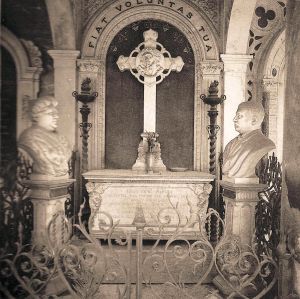 In 1909 the local sculptor Enrico Formaggini built another valuable chapel, that of Giovanni Sisini's family, which is lightened by wrought iron gates, while in the space between the two gates there is a cross on a small altar, in the background of which are engraved the words Fiat voluntas tua".
In 1909 the local sculptor Enrico Formaggini built another valuable chapel, that of Giovanni Sisini's family, which is lightened by wrought iron gates, while in the space between the two gates there is a cross on a small altar, in the background of which are engraved the words Fiat voluntas tua".
On the sides, above two steles, are the half busts of the Sisini couple, portrayed in a particularly realistic way, as well as the decorations and the wrought iron gate of the chapel.
Also noteworthy are the tombs made by the Sanremo sculptor Filippo Ghersi, like that of Sophie and Edward Johnson, made in 1867 and consisting in the lower part of a sacrificial altar adorned with a bas-relief depicting an angel in the act of removing two children from their mother's arms, while in the upper part of the sarcophagus the two little brothers of three and five years sleep tenderly embraced on a soft and welcoming mattress.
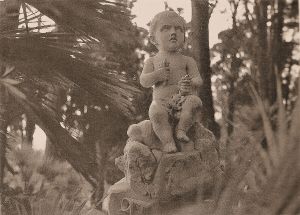 In Frederick Smith's tomb, made in 1876, Ghersi wanted instead to depict the little Frederick sitting on the tip of a rock with a frowning and severe gaze, while he holds a broken oak branch in his hands, perhaps an emblem of prematurely truncated life.
In Frederick Smith's tomb, made in 1876, Ghersi wanted instead to depict the little Frederick sitting on the tip of a rock with a frowning and severe gaze, while he holds a broken oak branch in his hands, perhaps an emblem of prematurely truncated life.
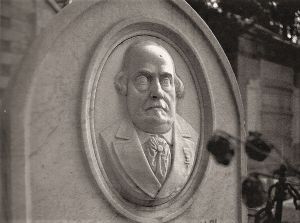 Also very realistic is the tomb of the doctor Alessandro Rambaldi, made by Ghersi in 1883, with the tombstone holder portrayed in a particularly faithful way to the original, with the same tone that also characterises two other tombs made by Ghersi: the Bogge tomb and the tomb of Laura Pesante (1886), which, although not signed, is almost certainly attributable to the production of the Matuziano sculptor.
Also very realistic is the tomb of the doctor Alessandro Rambaldi, made by Ghersi in 1883, with the tombstone holder portrayed in a particularly faithful way to the original, with the same tone that also characterises two other tombs made by Ghersi: the Bogge tomb and the tomb of Laura Pesante (1886), which, although not signed, is almost certainly attributable to the production of the Matuziano sculptor.
The tomb of Doctor Jacobson, made in 1881 by the Genoese Rota, is also of great interest. The figures, portrayed as a group of prayers, are detached from a false bas-relief consisting of a marble plane, in accordance with an exquisitely neo-Renaissance canon. Among the other numerous funerary sculptures that adorn the cemetery's sepulchres, characterised by the most varied styles such as those ascribable to Realism, Neoclassicism, Symbolism and Deco, there are in particular those due to famous artists, such as, in addition to the already mentioned Pasquali, Formaggini and Ghersi, the Sanremo-born Domenico Carli, former author of valuable funerary monuments in the Genoese cemetery of Staglieno.
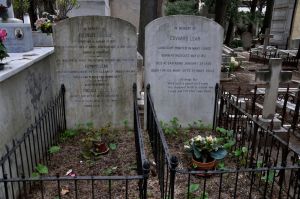
 Many other important people came to Sanremo from all over the world, and some of them died and were buried here. It is impossible to list them all here: the painter Edward Lear, the anatomist A.H. Hassall, Queen Victoria's court lady Caroline Giffard Phillipson, Prussian and Russian nobles and aristocrats, and many others even from North America and Australia.
Many other important people came to Sanremo from all over the world, and some of them died and were buried here. It is impossible to list them all here: the painter Edward Lear, the anatomist A.H. Hassall, Queen Victoria's court lady Caroline Giffard Phillipson, Prussian and Russian nobles and aristocrats, and many others even from North America and Australia.
The Monumental Cemetery of the Mouth is a hidden pearl of the city of Sanremo that has not yet received all the attention it deserves, but there are grounds to make it a PRACTICAL example of sustainable conservation and continuous care. 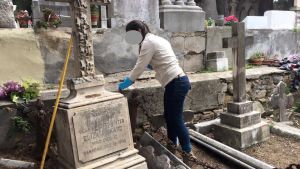 The interest of the local Cultural Associations has allowed a first small restoration intervention in agreement with the institutions: on July 9, 2015 the restoration of the tomb of A.H. Hassal was completed (thanks to funding from the Rotary Club Sanremo) and in November 2015 sporadic volunteer days began where anyone is welcome to carry out very simple maintenance operations under the supervision of experts in agreement with the Superintendence of Fine Arts.
The interest of the local Cultural Associations has allowed a first small restoration intervention in agreement with the institutions: on July 9, 2015 the restoration of the tomb of A.H. Hassal was completed (thanks to funding from the Rotary Club Sanremo) and in November 2015 sporadic volunteer days began where anyone is welcome to carry out very simple maintenance operations under the supervision of experts in agreement with the Superintendence of Fine Arts.
Overall, during its period of use in the cemetery of the Foce, the corpses of 40,000 people, including "sanremaschi", people from Sanremo and guests, compatriots and foreigners, were collected. The burials present in the cemetery are identified with the names on the graves, but some of them are not legible because they have been erased by their deterioration. Here below we show some of them.
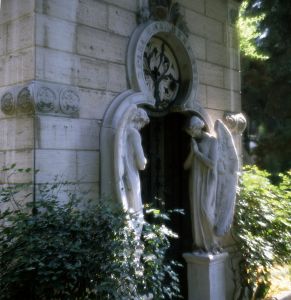
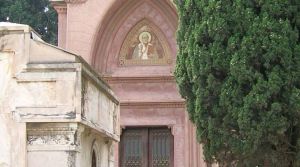
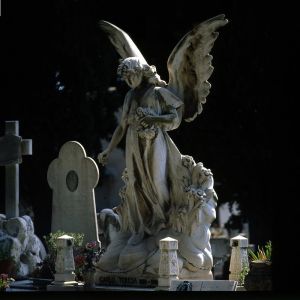
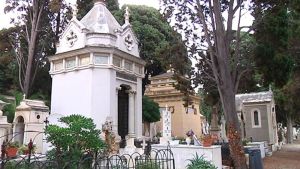
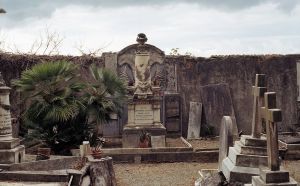
The management of the cemetery reflects the society of the time in the various periods and concerns the very century (1840-1949) that saw Sanremo transformed from a community of farmers and sailors into a tourist resort and cultural centre of international fame until the threshold of the Second World War, which on the one hand would have exalted its many economic potentialities and on the other hand would have mortified many values of the past and cut off ancient roots.
(fonti: testo a cura del Dott. Andrea Gandolfo; Immagini dall'Archivio del nostro Gruppo di Facebook)
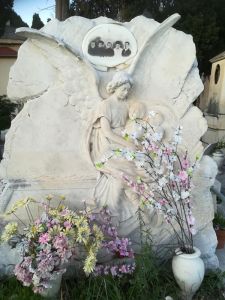
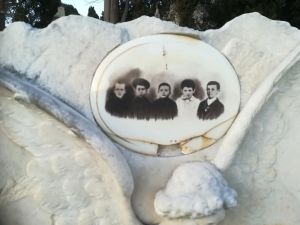 A sculptural group above a common grave remembers that on 13th February 1912, 5 children died in Corso Federico Guglielmo (today Trento and Trieste) falling into the abyss caused by sea erosion, which suddenly opened while they were walking with their schoolmates.
A sculptural group above a common grave remembers that on 13th February 1912, 5 children died in Corso Federico Guglielmo (today Trento and Trieste) falling into the abyss caused by sea erosion, which suddenly opened while they were walking with their schoolmates.
CREMATION IN SANREMO
The first time was in 1888
Some time ago there was talk of creating a crematory altar in Valle Armea, next to the cemetery of the same name.
But perhaps not everyone knows that in Sanremo, at the end of 1800 a crematorium was built right inside the cemetery of the Foce.
In Sanremo, in 1880, there was a Masonic Lodge "Liguria" in which many members of the board of directors of the local Socrem, the cremation company founded in Italy about ten years before.
At that time, exactly in 1886, the president of the "Società di cremazione dei cadaveri" Giobatta Rubino bought from the Semiglia brothers, at the price of 4 lire per metre, an area of 140 square metres, also on the west side of the cemetery, to be used for the construction of the crematory area.
Previously, during the Cremation Conference in 1883, thanks to the lawyer Siro Carli who proposed a grant of 2 thousand lire, after which the Crematory Temple in Sanremo was erected.  The building was completed and on March 16, 1888, the first cremation of the thirty-year-old German girl Alice Junk took place.
The building was completed and on March 16, 1888, the first cremation of the thirty-year-old German girl Alice Junk took place.
From that day the crematorium began to function regularly.
On 14 March 1893 the chemical industrialist Alfred Nobel wrote: "I hope that the money from my patent fees will be used for the construction of crematoria in large cities".
Then the Pontifical ban on cremation convinced Nobel that it would be difficult to give credit to his wishes and so the chemist changed the destination.
In 1910 the management of the Oven passed directly to the Municipality until the rise of the fascist power banned its use, as Cremation was a battle horse of Freemasonry and therefore outlawed.
Only in 1973 was Socrem reconstituted and even Canon Law no longer prohibited it.
The historic building that housed the crematorium has been partially restored and inside there is a magnificent Cinerario that houses many urns and is managed by the Socrem town.
(Articles from "La Riviera" of 22 September 2016)






